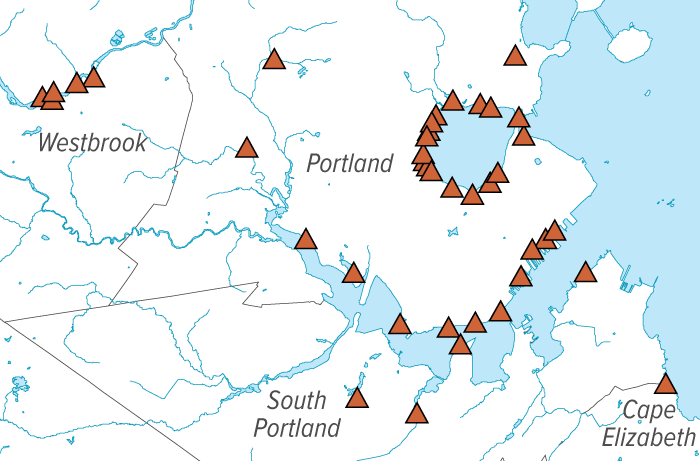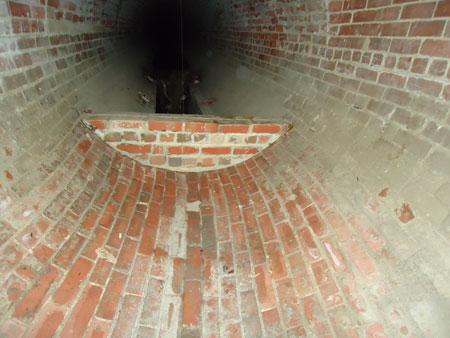Community Investments Have Reduced Pollution from Combined Sewer Overflows (CSOs)
Discharges from CSOs Dropped by Eighty Percent Over Two Decades
WHY IT MATTERS
The term “combined sewer overflows” refers to discharges of untreated or partially treated mixtures of sewage and stormwater into rivers or the Bay after rainstorms, imperiling water quality and public health.
When sewer systems were built in the Casco Bay watershed, even as late as the mid-twentieth century, it was common to install pipes that collected a combination of sewage and rainwater, and discharged the mixture into nearby waters. Today, those pipes (if they have not been replaced) normally carry the combined sewage and rainwater to a wastewater treatment plant instead. Heavy rainfall, however, can overwhelm the capacity of the sewer system or the wastewater plant, leading the overflow to be discharged—pollution and all—directly into a waterbody. Combined sewer overflows (CSOs) are therefore regulated, and municipalities are required to make progress reducing discharges.
Fixing this problem is challenging and expensive. Communities must build parallel stormwater and sanitary sewer systems (known as “sewer separation”), redesign combined sewers, or build underground tanks to store large volumes of combined waters after storms, which are then released gradually to wastewater treatment facilities.
STATUS
CSO volumes have, on average, declined 7.5 percent each year across the Casco Bay watershed over the past two decades. Portland, South Portland, Westbrook, and Cape Elizabeth had permitted CSOs in 2019. Portland accounted for most CSOs, by volume, events, and locations. All four communities and Portland Water District are working to reduce CSO discharges.
CSO Outfall Locations
Number, Volume, and Reductions of Combined Sewer Overflows (CSOs)
| Community | Storms with Measurable CSO Discharges 2019 | Permitted Outfalls 2019 | CSO Volume 2019 (millions of gallons) | Percent Reduction 1997-1999 vs 2017-2019 |
|---|---|---|---|---|
| Cape Elizabeth | 2 | 1 | 0.4 | 93% |
| Portland and Portland Water District | 46 | 30 | 184.5* | 78% |
| South Portland | 3 | 4 | 8.7 | 95% |
| Westbrook | 4 | 5 | 9.8 | 88% |
| TOTAL | N/A** | 40 | 203.4 | 80% |
** A total is not applicable in this column because the same storm may cause CSO discharges in multiple communities.
Decrease in CSO Volumes in Casco Bay Watershed
Portland CSO Volumes by Site
westbrook projects reduce dischargeS to presumpscot river
Two projects completed in 2011 by the Portland Water District (PWD) in Westbrook reduced CSO volumes with good engineering. The projects took place at the Warren Avenue and Dunn Street CSO regulators. Both of those CSOs discharge to the Presumpscot River and ultimately to Casco Bay.
The Warren Avenue project replaced an eight-inch combined sewer with an eighteen-inch alternative able to handle larger flows. Since completion of the project, the site has experienced a 77 percent decrease in CSO volumes, with no overflow events recorded since 2013.
The Dunn Street project replaced an eight-inch pipe with a sixteen-inch pipe. A related structure, known as a weir, was elevated by two feet. The weir prevents sewage or runoff from entering the Presumpscot River under normal flow conditions and allows flow to be conveyed to the treatment facility.
successes & challenges
- Portland Water District (PWD) has a sophisticated monitoring system that tracks CSO volumes in real time at many outfalls. PWD staff use the data to identify emerging problems and improve operations of the sewer systems.
- Despite the rising costs of remediation and some delays in implementing State-mandated Long-Term Control Plans, Casco Bay communities have made substantial progress over the past twenty years in reducing CSOs, and progress looks likely to continue.
- Current plans call for continued investment of tens of millions of dollars in CSO abatement but not closure of all CSOs. Costs to eliminate the last few climb rapidly, and greater water quality benefit may be achievable by investing in other water quality solutions.
- A primary goal of the CSO abatement effort has been to remove CSO discharges from small streams. Portland accomplished that for Fall Brook but still has CSO outfalls in Capisic and Nasons Brooks. South Portland still has a CSO outfall to Barberry Creek and one to Calvary Pond. Elimination of CSO outfalls to these vulnerable waters remains a priority.
- In 2019, wet weather bypass flows at Portland’s East End Wastewater Treatment Facility—which receive partial treatment, including disinfection, and so pose a lower human health risk—were nearly 1.3 times the CSO volumes. For comparison, the facility’s total permitted discharges of treated wastes are twenty-five times greater.
View a PDF version of this page that can be downloaded and printed.
View references, further reading, and a summary of methods and data sources.
STATE OF CASCO BAY
Drivers & Stressors
What’s Affecting the Bay?
Human Connections
What’s Being Done?
If you would like to receive a printed State of Casco Bay report, send an email request to cbep@maine.edu.
This document has been funded by the U.S. Environmental Protection Agency under Cooperative Agreements #CE00A00348-0 and #CE00A00662-0 with the University of Southern Maine.
Suggested citation: Casco Bay Estuary Partnership. State of Casco Bay, 6th Edition (2021).

